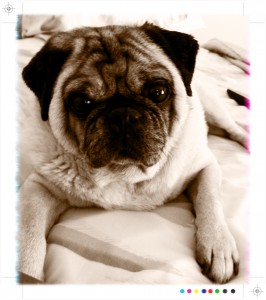 Cataracts: Meet Snuggles, a 12 1/2 year old pug from Wall, Township NJ, who had cataracts from diabetes and had cataract surgery to restore vision.
Cataracts: Meet Snuggles, a 12 1/2 year old pug from Wall, Township NJ, who had cataracts from diabetes and had cataract surgery to restore vision.
What Are Cataracts?
Cataracts are when the lens in the eye becomes opaque (less transparent) to light. This can result in less or no light hitting the retina in the back of the eye and decreased or loss of vision. (See diagram) Cataracts can be small and mild, known as immature cataracts only partially affecting vision. Cataracts can also be very opaque and not allow lights passage, known as mature cataracts, which may result in blindness. Cataracts must be differentiated from nuclear sclerosis, a normal aging change of the lens, by a veterinarian. Nuclear sclerosis is a grayish-blue haze to the lens that pet owners sometimes notice and confuse with cataracts, vision is normal with nuclear sclerosis.
Causes of Cataracts:
There are many causes of cataracts including genetics and breed. For example some retrievers, spaniels and terriers are prone to developing cataracts. Old age (senile) cataracts can be seen in older dogs especially small breed dogs. Diabetes in dogs, but not cats, is a very common cause of cataracts. Most diabetic dogs become blind within a year or so of diagnosis, even with proper insulin therapy. Other causes include trauma to the eye, inflammation and infection of the eye, poor nutrition in puppies and radiation therapy among other causes.
Cataract Signs:
Signs you may notice are a decrease in vision, especially night vision, or you may notice the pupil looks “white”. If you think you notice these signs you should bring your pet to a veterinarian for a comprehensive diagnosis.
Cataracts Treatment:
The treatment of choice for cataracts is surgical removal of the cataract performed by a veterinary ophthalmologist. Phacoemulsification is a procedure using a specialized ultrasonic instrument to break up and remove the cataractous lens. Usually an artificial lens is implanted to replace the removed one. Surgical complications are discussed with the ophthalmologist ahead of time, but most dogs go on to have good vision after the procedure.
To schedule your appointment today, please do not hesitate to get in touch! We will make it the best experience possible for you and your four legged friend!
Squan Animal Hospital LLC 1427 Lakewood Rd Manasquan, NJ 08736 Phone: 732-528-9199 Fax: 732-528-0769 E-Mail: cs@squananimalhospital.com